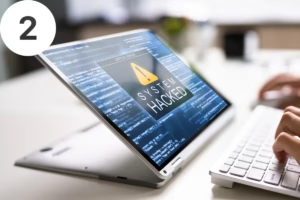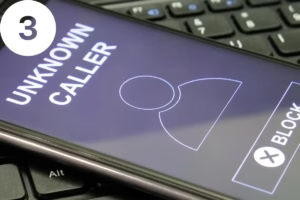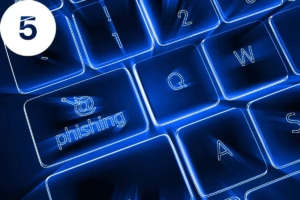Introduction
Phishing scams have become more sophisticated than ever, leveraging AI, deepfake technology, and advanced social engineering tactics to deceive even the most vigilant individuals. Cybercriminals continuously refine their methods, making it essential for businesses and employees to stay informed and protected. This article explores the latest phishing techniques, how to identify them, and proactive measures to prevent attacks.
Understanding Modern Phishing Scams
Phishing attacks have evolved from simple email scams to highly personalized, AI-driven threats. Attackers now use multiple communication channels, including SMS, phone calls, and deepfake videos, to manipulate victims. Recognizing the core characteristics of phishing can help individuals and businesses mitigate these attacks before they cause damage.
Types of Phishing Attacks
1. Spear Phishing

Spear phishing targets specific individuals or organizations using personal information to create convincing attacks.
Cybercriminals research victims through social media and public data to craft emails that appear legitimate. These emails often contain urgent requests or malicious links leading to fake login pages.
2. Smishing (SMS Phishing)

Smishing uses fraudulent text messages that appear to be from trusted sources, such as banks, government agencies, or service providers. These messages often contain urgent requests or malicious links designed to steal credentials or install malware.
3. Vishing (Voice Phishing)

Vishing involves fraudsters posing as IT support, financial institutions, or government agencies over the phone. Attackers use AI-generated voices and caller ID spoofing to make their scams more convincing.
4. Business Email Compromise (BEC)

BEC attacks involve cybercriminals impersonating executives or business partners to trick employees into making unauthorized transactions or sharing confidential data. These attacks often bypass security checks by using compromised or spoofed email accounts.
5. AI-Powered & Deepfake Phishing Attacks

Attackers now leverage AI to generate highly realistic phishing emails, clone voices, and create deepfake videos. This technology allows them to impersonate CEOs, HR personnel, or financial officers, making scams harder to detect.
6. Clone Phishing

Clone phishing occurs when attackers copy legitimate emails and resend them with malicious attachments or links. The email appears identical to the original, making it difficult to detect.
How to Prevent Phishing Attacks
1. Implement Multi-Factor Authentication (MFA)
MFA adds an extra layer of security by requiring additional authentication factors beyond just a password. Even if attackers obtain login credentials, they are less likely to gain access.
2. Use Advanced Email Filtering and Security Tools
Organizations should implement email filtering, domain authentication protocols like DMARC, SPF, and DKIM, and advanced threat detection tools to prevent phishing emails from reaching employees. The National Cyber Security Centre’s Phishing Prevention Guide provides further insights into securing email systems.
3. Conduct Security Awareness Training
Employees should be trained to recognize phishing attempts, report suspicious messages, and follow security best practices. The OCC Phishing Attack Prevention Resources recommend regular training as a key component in reducing cyber threats.
4. Verify Communications Before Responding
Always verify emails, phone calls, and text messages before responding. If an email appears suspicious, contact the sender directly using a trusted phone number or official website.
5. Keep Software and Systems Updated
Ensure that all systems, applications, and antivirus programs are updated. Regular updates help patch vulnerabilities that attackers could exploit.
6. Report and Monitor Phishing Attempts
Encourage employees to report suspicious emails and messages to the IT security team. Organizations should continuously monitor and analyze phishing attempts to improve defense strategies.
How Advanced IT Support Helps Prevent Phishing Attacks
Managed IT Services for Cybersecurity
Advanced IT Support provides Managed IT Services that proactively monitor networks and prevent phishing attacks. By identifying and neutralizing threats early, businesses can stay protected.
Comprehensive Cybersecurity Solutions
Through Cybersecurity Services, Advanced IT Support helps businesses assess vulnerabilities, implement security measures, and protect sensitive data with real-time threat monitoring and incident response.
IT Support and Helpdesk for Rapid Response
With IT Support and Helpdesk Services, businesses have swift assistance in case of phishing incidents. Expert teams guide employees through secure protocols and best practices.
Cloud Security & Data Protection
As part of Cloud Services, Advanced IT Support offers encrypted storage, access control, and disaster recovery planning, ensuring sensitive data remains protected from phishing threats.
What to Do If You Fall Victim to a Phishing Scam
- Change your passwords and enable MFA on affected accounts.
- Contact your financial institution if payment or banking information was involved.
- Report the attack to your IT security team and relevant authorities.
- Monitor your accounts for unusual activity and set up fraud alerts if necessary.
Staying Ahead of Evolving Phishing Threats
- Regularly update passwords and enable security features.
- Keep software and antivirus solutions up to date.
- Monitor cybersecurity trends and participate in awareness programs.
- Encourage a security-first culture within your organization.
Conclusion
Phishing scams continue to evolve, making cybersecurity awareness and proactive protection more critical than ever. By partnering with Advanced IT Support, businesses gain access to cutting-edge Managed IT Services, Cybersecurity Solutions, IT Support, Network Support, and Cloud Services to safeguard their operations.

